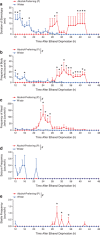Attenuation of ethanol withdrawal by ceftriaxone-induced upregulation of glutamate transporter EAAT2
- PMID: 24452391
- PMCID: PMC4023140
- DOI: 10.1038/npp.2014.14
Attenuation of ethanol withdrawal by ceftriaxone-induced upregulation of glutamate transporter EAAT2
Abstract
Alcohol withdrawal syndrome (AWS) is a potentially fatal outcome of severe alcohol dependence that presents a significant challenge to treatment. Although AWS is thought to be driven by a hyperglutamatergic brain state, benzodiazepines, which target the GABAergic system, comprise the first line of treatment for AWS. Using a rat model of ethanol withdrawal, we tested whether ceftriaxone, a β-lactam antibiotic known to increase the expression and activity of glutamate uptake transporter EAAT2, reduces the occurrence or severity of ethanol withdrawal manifestations. After a 2-week period of habituation to ethanol in two-bottle choice, alcohol-preferring (P) and Wistar rats received ethanol (4.0 g/kg) every 6 h for 3-5 consecutive days via gavage. Rats were then deprived of ethanol for 48 h during which time they received ceftriaxone (50 or 100 mg/kg, IP) or saline twice a day starting 12 h after the last ethanol administration. Withdrawal manifestations were captured by continuous video recording and coded. The evolution of ethanol withdrawal was markedly different for P rats vs Wistar rats, with withdrawal manifestations occurring >12 h later in P rats than in Wistar rats. Ceftriaxone 100 mg/kg per injection twice per day (200 mg/kg/day) reduced or abolished all manifestations of ethanol withdrawal in both rat variants and prevented withdrawal-induced escalation of alcohol intake. Finally, ceftriaxone treatment was associated with lasting upregulation of ethanol withdrawal-induced downregulation of EAAT2 in the striatum. Our data support the role of ceftriaxone in alleviating alcohol withdrawal and open a novel pharmacologic avenue that requires clinical evaluation in patients with AWS.
Figures




References
-
- Alele PE, Devaud LL. Differential adaptations in GABAergic and glutamatergic systems during ethanol withdrawal in male and female rats. Alcoholism Clin Exp Res. 2005;29:1027–1034. - PubMed
Publication types
MeSH terms
Substances
Grants and funding
LinkOut - more resources
Full Text Sources
Other Literature Sources

